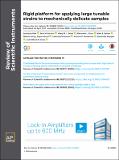Files in this item
Rigid platform for applying large tunable strains to mechanically delicate samples
Item metadata
| dc.contributor.author | Park, Joonbum | |
| dc.contributor.author | Bartlett, Jack M. | |
| dc.contributor.author | Noad, Hilary M.L. | |
| dc.contributor.author | Stern, Alexander L. | |
| dc.contributor.author | Barber, Mark E. | |
| dc.contributor.author | König, Markus | |
| dc.contributor.author | Hosoi, Suguru | |
| dc.contributor.author | Shibauchi, Takasada | |
| dc.contributor.author | Mackenzie, Andrew P. | |
| dc.contributor.author | Steppke, Alexander | |
| dc.contributor.author | Hicks, Clifford W. | |
| dc.date.accessioned | 2020-08-26T11:30:03Z | |
| dc.date.available | 2020-08-26T11:30:03Z | |
| dc.date.issued | 2020-08-03 | |
| dc.identifier | 269803204 | |
| dc.identifier | ab5e9622-c80c-4845-98c8-3d965b48ad2b | |
| dc.identifier | 85089385326 | |
| dc.identifier | 000559810300002 | |
| dc.identifier.citation | Park , J , Bartlett , J M , Noad , H M L , Stern , A L , Barber , M E , König , M , Hosoi , S , Shibauchi , T , Mackenzie , A P , Steppke , A & Hicks , C W 2020 , ' Rigid platform for applying large tunable strains to mechanically delicate samples ' , Review of Scientific Instruments , vol. 91 , no. 8 , 083902 . https://doi.org/10.1063/5.0008829 | en |
| dc.identifier.issn | 0034-6748 | |
| dc.identifier.uri | https://hdl.handle.net/10023/20516 | |
| dc.description | The authors acknowledge the financial support from the Max Planck Society. J.P. acknowledges the financial support from the National Research Foundation of Korea (NRF) funded by the Ministry of Science and ICT (Grant No. 2016K1A4A4A01922028). Work in Japan was supported by a Grant-in-Aid for Scientific Research on Innovative Areas “Quantum Liquid Crystals” (Grant No. JP19H05824) from the Japan Society for the Promotion of Science. | en |
| dc.description.abstract | Response to uniaxial stress has become a major probe of electronic materials. Tunable uniaxial stress may be applied using piezoelectric actuators, and so far two methods have been developed to couple samples to actuators. In one, actuators apply force along the length of a free, beam-like sample, allowing very large strains to be achieved. In the other, samples are affixed directly to piezoelectric actuators, allowing the study of mechanically delicate materials. Here, we describe an approach that merges the two: thin samples are affixed to a substrate, which is then pressurized uniaxially using piezoelectric actuators. Using this approach, we demonstrate the application of large elastic strains to mechanically delicate samples: the van der Waals-bonded material FeSe and a sample of CeAuSb2 that was shaped with a focused ion beam. | |
| dc.format.extent | 10 | |
| dc.format.extent | 3998170 | |
| dc.language.iso | eng | |
| dc.relation.ispartof | Review of Scientific Instruments | en |
| dc.subject | QC Physics | en |
| dc.subject | Instrumentation | en |
| dc.subject | DAS | en |
| dc.subject.lcc | QC | en |
| dc.title | Rigid platform for applying large tunable strains to mechanically delicate samples | en |
| dc.type | Journal article | en |
| dc.contributor.institution | University of St Andrews. School of Physics and Astronomy | en |
| dc.contributor.institution | University of St Andrews. Condensed Matter Physics | en |
| dc.identifier.doi | 10.1063/5.0008829 | |
| dc.description.status | Peer reviewed | en |
This item appears in the following Collection(s)
Items in the St Andrews Research Repository are protected by copyright, with all rights reserved, unless otherwise indicated.

